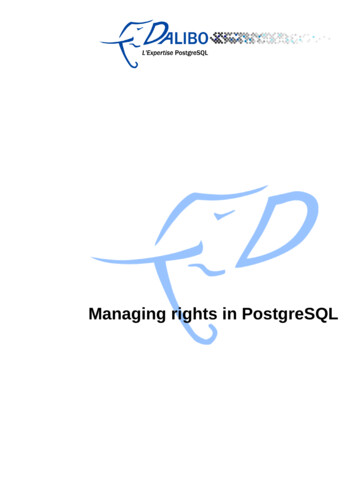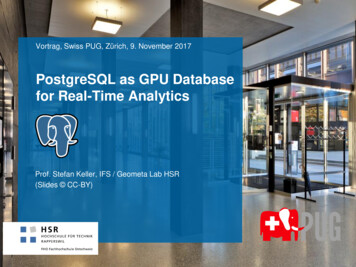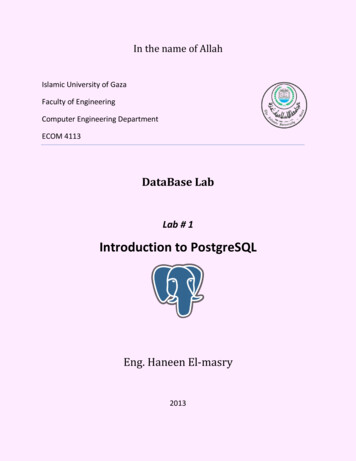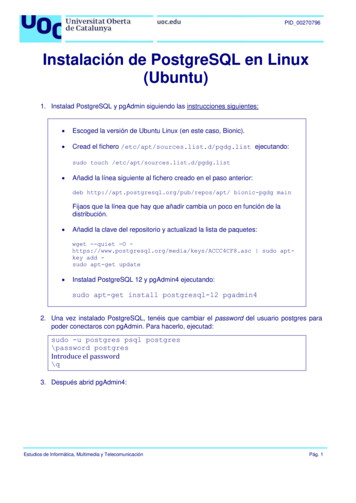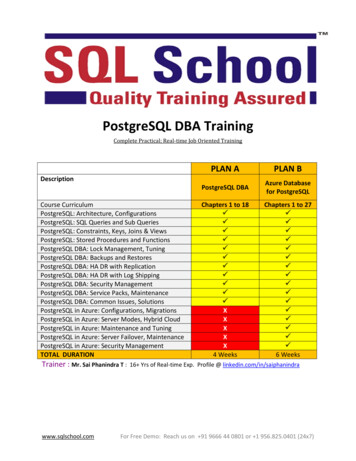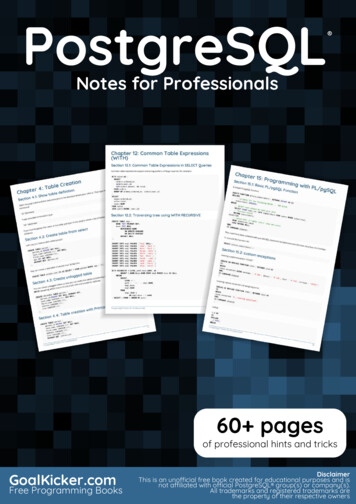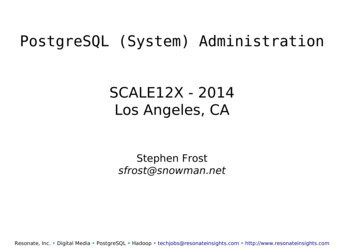
Transcription
PostgreSQL (System) AdministrationSCALE12X - 2014Los Angeles, CAStephen Frostsfrost@snowman.netResonate, Inc. Digital Media PostgreSQL Hadoop techjobs@resonateinsights.com http://www.resonateinsights.com
Stephen Frost PostgreSQL Major Contributor, Committer Implemented Roles in 8.3 Column-Level Privileges in 8.4 Contributions to PL/pgSQL, PostGIS Resonate, Inc. Principal Database Engineer Online Digital Media Company We're Hiring! - techjobs@resonateinsights.com
Do you read. planet.postgresql.org
Agenda Terms Installation Initial configuration Getting connected Users / Roles Permissions Backups Monitoring Extensions
Terms "Cluster" ; aka "Instance" One PG server one "postmaster" - listens on one port One set of data files (including tablespaces) Users/Roles and tablespaces at cluster level Replication at cluster level
Terms (continued) "Tablespace" Alternate directory/filesystem for PG to store data Perms must be 0700, owned by postgres Must explicitly GRANT create rights Can contain objects from any database "Database" Lives inside a cluster Schemas at the database level "Schema" Lives inside a database
Tables, views, functions at the schema level Default 'public' schema allows anyone to create
Installation Debian/Ubuntu/etc apt.postgresql.org Add PGDG sources.list.d RedHat/CentOS/etc yum.postgresql.org Download & Install PGDG RPM Multiple Major Versions
Debian Install Configs in /etc/postgresql/X.Y/main/ Initial DB in /var/lib/postgresql/X.Y/main Binaries into /usr/lib/postgresql/X.Y/bin Logs into /var/log/postgresql/ Startup logs in /var/log/postgresql also One init script starts all major versions
Debian "Clusters" Debian provides wrappers and helper scripts pg lsclusters - lists all PG clusters pg ctlcluster - Control specific clusters --cluster option - Specify specific cluster psql --cluster 9.2/main pg dump --cluster 9.2/main, etc .
RedHat Install Configs in data directory Default DB in /var/lib/pgsql/X.Y/data Create DB with 'service postgresql-9.2 initdb' Binaries into /usr/pgsql-X.Y/bin Logs into /var/lib/pgsql-X.Y/data/pg log Startup logs in /var/lib/pgsql-X.Y/pgstartup.log Init script per major version
PostgreSQL Data Directory "Some thing in here do not react well to bullets." On Debian, just stay out of it On RedHat, be careful to only modify postgresql.conf pg hba.conf pg ident.conf pg log/ Do NOT touch files in pg xlog or other dirs pg xlog is PG's WAL- not just normal log files
Initial postgresql.conf listen addresses '*' (for external access) checkpoint segments 30 Uses more disk space in pg xlog Never let that partition run out of space! checkpoint completion target 0.9 Targets finishing in 90% of time given effective cache size half the RAM Never allocated, just for planning max wal senders 3 More later.
Logging postgresql.conf log connections on log disconnections on line prefix '%m [%p]: %q [%l-1] %d %u@%r %a ' log lock waits on log statement 'ddl' log min duration statement 100 log temp files 0 log autovacuum min duration 0
pg hba.conf Controls how users are BASEDATABASEDATABASEUSERUSERUSERUSERMETHOD [OPTIONS]ADDRESS METHOD [OPTIONS]ADDRESS METHOD [OPTIONS]ADDRESS METHOD [OPTIONS] Read in order, top-to-bottom, first match is used 'hostssl' requires SSL connection, no is not SSL Special DBs - 'all', 'sameuser', 'replication' Special Users - 'all', ' ' prefix for role membership Address can be IPv4 or IPv6, can include CIDR mask Special 'reject' method
Authentication Methods The ones you should use . peer Secure, unix-socket-based auth Checks the Unix username of the user gss (Kerberos) Integreates w/ MIT/Heimdal Kerberos and AD Recommended for Enterprise deployments cert (SSL Certificate) Client-side certificate based authentication Use pg ident to map CNs to PG usernames
Authentication Methods Acceptable, but not ideal. md5 Stock username/password Use SSL if you're worried about security pam Modules run as postgres user Can't be used directly w/ pam unix saslauthd can make it work (pam sasl, saslauthd) radius Use SSL if you're worried about security
Auth Method Don'ts trust - Never use this- no auth done password - Password sent in cleartext sspi Windows-specific Uses Kerberos/GSSAPI underneath ident Insecure, don't trust it- use 'peer' for local ldap Auths against an LDAP server Use Kerberos/GSSAPI if you can
pg ident.conf Defines mappings which are used in pg N.NETstephen.frostpg-usersfrostsfrost External-user to PG-user mappings Unix user 'joe' can be PG user 'bob' Regexps can be used- but be careful Also works for Kerberos, client certs, etc.
Debian configs Extra config files in Debian/Ubuntu start.conf Controls start of this cluster Can be 'auto', 'manual', 'disabled' pg ctl.conf Options to pass to pg ctl Generally don't need to modify it environment Controlls environment PG starts in Generally don't need to modify it
RedHat configs Basically just the init.d scripts.
Connecting sudo su - postgres psql \? to see backslash-commands \h to get help on SQL queries/commands Exit with \q or ctrl-d psql -h localhost
Looking around table pg stat activity; - aka 'w' \l - list databasesName Owner Encoding Collate Ctype Access privileges----------- ---------- ---------- ------------- ------------- ----------------------postgres postgres UTF8 en US.UTF-8 en US.UTF-8 template0 postgres UTF8 en US.UTF-8 en US.UTF-8 c/postgres template1 postgres UTF8 en US.UTF-8 en US.UTF-8 c/postgres \dn - list schemasName Owner-------- ---------public postgres \db - list tablespacesName Owner Location------------ ---------- ---------pg default postgres pg global postgres
User setups createuser / CREATE USER \password to set passwords Privileges Superuser- Do not give this out CreateRole- Creation and modification of roles CreateDatabase- Allows database creation Login- Allows user to connect to DB Replication- Only for replication/system user Admin- Allows changing role memberships Inherit- Automatically get privileges
Roles Users are really roles Groups are implemented with roles CREATE ROLE (or just createuser --nologin) Same privilege options Can start as nologin, then be granted login Can cascade Any role can be GRANT'd to any other role Inherit is default, acts like group privs Noinherit means user must run 'set role', ala sudo
Permissions 'public' means 'all users' GRANT / REVOKE to give/take away privs, roles, etc CONNECT privs on the database (public by default) schemas - CREATE, USAGE recommend dropping 'public' or revoke CREATE Use per-user or per-app schemas tables - SELECT/INSERT/UPDATE/DELETE/TRUNCATE view - same (incl update!); execute as view owner columns - SELECT/INSERT/UPDATE functions - 'SECURITY DEFINER' are akin to setuid
Default perms Generally 'secure-by-default' Except functions- EXECUTE granted by default Owners have all rights on their objects Membership in owning role ownership ALTER DEFAULT PRIVILEGES - for roles FOR ROLE . IN SCHEMA . GRANT Can't be applied to just a schema GRANT . ON ALL . IN SCHEMA For tables, views, sequences, functions One-time operation, new tables will not have privs
Tuning For a dedicated server shared buffers Will be dedicated to PG for cacheing Up to half of main memory Try 2G on larger servers, more may not help Pre-9.3, need to bump sysctl params Post-9.3, you don't! Defaults to 128MB
Tuning (continued) work mem Used for in-memory hashing, sorts, etc Can be increased inside a given connection Used many times over- not a hard limit Per connection, so be careful Defaults to 1MB (wayy too small.) maintenance work mem Used for building indexes Make it larger before building an index Defaults to 16MB (that's a very small index)
Tuning (continued) effective cache size Tells PG how much of the DB is in memory Half of main memory Never allocated, only for planning purposes Defaults to 128MB autovacuum On a high-rate server, make it more aggressive Increase max workers Decrease autovacuum vacuum cost delay Defaults are for lightly loaded systems
Config Bump-Ups max connections 100 Consider using pg bouncer # connections # of CPUs is ideal shared buffers couple gig Probably not more than 3-4G (Test!) maintenance work mem maybe a gig Used for building indexes max locks per transaction 128 More if you have lots of objects # locks available is actually this * max conn
Backups Extremely important! pg basebackup w/ WAL recieve Binary-based backup MUST have WAL files backed up also! Needs to connect to 'replication' DB pg dump Logical, text-based backup Does not back up indexes, must rebuild Requires lightweight locks on everything Test restoring your data!
Monitoring check postgres.pl Useful with Nagios, Icinga, MRTG, etc. Provides metrics as well as monitoring Allows custom query for monitoring Minimum set of checksarchive ready (if doing WAL archiving)autovac freezebackends (Metric)dbstats (Metrics)listener (If using LISTEN/NOTIFY)locks (Metric)pgbouncer options (if using pgbouncer)txn idletxn timetxn wraparound---------------------Number of WAL .ready filesHow close to Autovacuum Max FreezeNumber of Backends runningLots of different statsChecks if anyone is LISTEN'ingNumber of locks heldVarious pgbouncer checksTransactions idle for X timeTransactions longer than X timeHow close to transaction wraparound
Extensions Install -contrib package Use PGXN - http://pgxn.org table pg available extensions;name default version installed version comment-------------------- ----------------- ------------------- -------------------file fdw 1.0 foreign-data wrapper for flat file accessdblink 1.0 connect to other PostgreSQL databases from within a databaseplpgsql 1.0 1.0 PL/pgSQL procedural languagepg trgm 1.0 text similarity measurement and index searching based on trigramsadminpack 1.0 administrative functions for PostgreSQLip4r 2.0 hstore 1.1 data type for storing sets of (key, value) pairs adminpack allows superuser to change anything. \dx lists installed extensions
Thank you!Stephen Frostsfrost@snowman.net@net snow
One PG server one "postmaster" - listens on one port One set of data files (including tablespaces) . Logs into /var/log/postgresql/ Startup logs in /var/log/postgresql also . Useful with Nagios, Icinga, MRTG, etc. Provides metrics as well as monitoring
